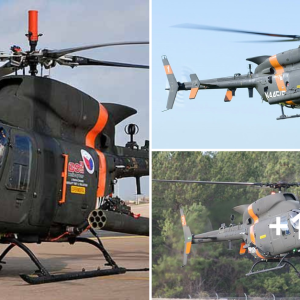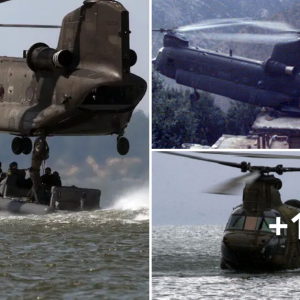Millions of American, coalition, and foreign-national personnel have benefited from HH-60 crews performing recovery and medical evacuations. The United States Air Force (USAF) is the United States Armed Forces’ air service arm. It is one of the US’ eight uniformed services. On August 1, 1907, it was constituted as part of the United States Army. The United States Air Force is a military service branch of the Department of the Air Force, one of the U.S. Department of Defense’s three military departments.

As of September 2012, the US Air Force had 5,638 aircraft in service. Until 1962, the Army and Air Force used the same naming system for aircraft, while the U.S. Navy used a different one. These were merged into a single system in 1962, which was influenced mainly by the Army and Air Force. Among the Airforce’s aircraft is the Sikorsky HH-60 Pave Hawk, which is used for search and rescue.
Introducing The Sikorsky HH-60G Pave Hawk
The US Air Force uses the Sikorsky MH-60G/HH-60G Pave Hawk, a twin-turboshaft engine helicopter. It’s based on the UH-60 Black Hawk and features the PAVE electronic systems program from the US Air Force. The Sikorsky S-70 family includes the HH-60/MH-60. The Air Combat Command (ACC), U.S. Air Forces in Europe (USAFE), Pacific Air Forces (PACAF), Air Education and Training Command (AETC), Air Force Reserve Command (AFRC), and the Air National Guard (ANG) all use the HH-60G Pave Hawk as of 2015.

The Pave Hawks have being employed for combat search and rescue coverage for coalition Air Forces in western Iraq, Saudi Arabia, coastal Kuwait, and the Persian Gulf during Operation Desert Storm. The Pave Hawk provided continuous combat search and rescue coverage for NATO air forces during Operation Allied Force and successfully rescued two US pilots. Pave Hawks have been deployed in support of the Army and Marine Corps during Operation Iraqi Freedom, Operation New Dawn, and Operation Enduring Freedom.
Features Of The Sikorsky HH-60 Pave Hawk
The UH-60A Black Hawk was first developed in 1981. The Air Force first used the helicopter in 1982. It received an in-flight refueling probe as well as a 97.5-gallon auxiliary fuel tank. In 1991, the modified variant was dubbed the HH-60G Pave Hawk. (PAVE is an acronym for Precision Avionics Vectoring Equipment). The Pave Hawk is a Sikorsky UH-60 Black Hawk helicopter that has been significantly modified.

The HH-60G has an autonomous flight control system, night vision goggles lighting, and a forward-looking infrared system, all of which help night low-level operations significantly. A radar warning receiver, an infrared jammer, and a flare/chaff countermeasure delivery system are among the Pave Hawk combat improvements. Included is a HH-60G rescue kit with a hoist capable of lifting 600 lbs of cargo from a hover height of 200 feet, alongside a personnel-locating system. There have been 112 HH-60Gs manufactured since 1982. Civil search and rescue, medical evacuation, catastrophe response, humanitarian help, security cooperation/aviation guidance, NASA space flight support, and rescue are examples of civil search and rescue services; command and control are among the military missions assigned to the HH-60G.
The Pave Hawk is a heavily modified Army Black Hawk helicopter with enhanced communication and navigation suite that incorporates inertial navigation/global positioning/Doppler navigation systems, satellite communications, and secure voice communications. The HH-60G is equipped with a color weather radar and an anti-ice system for the engine and rotor blades, making it capable of flying in bad weather. A retractable in-flight refueling probe, internal auxiliary fuel tanks, two crew-served 7.62mm or .50 caliber machine guns, and an 8,000 lbs cargo hook are all part of the Pave Hawk mission equipment. All HH-60Gs have foldable rotor blades to facilitate air transportability and maritime operations.

Specifications
The aircraft has a Crew of four (two pilots and two unique mission aviators/aerial gunners) with a maximum crew of 6–12 troops, litters, and additional cargo. It has a length of 64 feet 10 inches, a height of 16 feet 8 inches, an empty weight of 16,000 lbs and a maximum takeoff weight of 22,000 lbs with two General Electric T700-GE-700 / -701C turboshaft engines producing 1,940 HP (1,450 kW) and a main rotor diameter of 52 ft 8 in (16.05 m). It has a maximum speed of 193 kn (222 MPH), a cruise speed of 159 kn (183 MPH), a range of 324 nautical miles (373 MPH), a ferry range of 441 nautical miles (507 MPH), and a service ceiling of 14,000 feet (4,300 m). The HH-60G is armed with two 7.62 mm (0.308 in) mini guns or two .50 caliber machine guns (12.7 mm) Heavy machine guns GAU-18/A.

The HH-60W
The HH-60W is an enhanced version of the combat-proven UH-60M Black Hawk helicopter that will eventually replace the HH-60G Pave Hawk medium-lift combat search-and-rescue helicopter, which was introduced in 1982. The new helicopter is intended for casualty evacuation, medical evacuation, non-combatant evacuation missions, civil search-and-rescue, humanitarian aid, disaster relief, and civil search-and-rescue missions.
Boeing Vertol

The Boeing Vertol YUH-61 (Model 179) was a medium-lift military assault/utility helicopter with twin turbine engines. In the early 1970s, the YUH-61 came in second place in the US Army Utility Tactical Transport Aircraft System (UTTAS) competition to replace the Bell UH-1 Iroquois helicopter. Sikorsky Aircraft was granted a contract to develop the aircraft after the fly-off program. It has run-dry gearboxes, ballistically tolerant, redundant subsystems (hydraulic, electrical, and flight controls), crashworthy crew (armored) and troop seats, dual-stage oleo main landing gear, and a quieter main construction.
What We Love About The Aircraft

Finally, a few things to love about the HH-60 include the fact that Pave Hawks are equipped with an over-the-horizon tactical data receiver that can receive mission update information in near real-time. Millions of American, coalition, and foreign-national personnel have benefited both directly and indirectly from HH-60 crews performing personnel recovery and medical evacuations (MEDEVAC) operations in low visibility, low illumination conditions at all altitudes.





